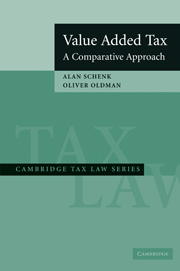Book contents
- Frontmatter
- Contents
- List of Tables, Figures, and Charts
- List of Cases
- Preface to the Revised Edition
- Value Added Tax
- 1 SURVEY OF TAXES ON CONSUMPTION AND INCOME, AND INTRODUCTION TO VALUE ADDED TAX
- 2 FORMS OF CONSUMPTION-BASED TAXES AND ALTERING THE TAX BASE
- 3 VARIETIES OF VAT IN USE
- 4 REGISTRATION, TAXPAYER, AND TAXABLE BUSINESS ACTIVITY
- 5 TAXABLE SUPPLIES OF GOODS AND SERVICES, AND TAX INVOICES
- 6 THE TAX CREDIT MECHANISM
- 7 INTRODUCTION TO CROSS-BORDER ASPECTS OF VAT
- 8 TIMING, TRANSITION AND VALUATION RULES
- 9 ZERO RATING AND EXEMPTIONS AND GOVERNMENT ENTITIES AND NONPROFIT ORGANIZATIONS
- 10 GAMBLING AND FINANCIAL SERVICES (OTHER THAN INSURANCE)
- 11 INSURANCE
- 12 INTERJURISDICTIONAL ASPECTS OF VAT IN FEDERAL COUNTRIES AND COMMON MARKETS
- 13 REAL PROPERTY
- 14 PROPOSALS FOR U.S. TAX ON CONSUMPTION
- APPENDIXES
- Index
6 - THE TAX CREDIT MECHANISM
Published online by Cambridge University Press: 06 January 2010
- Frontmatter
- Contents
- List of Tables, Figures, and Charts
- List of Cases
- Preface to the Revised Edition
- Value Added Tax
- 1 SURVEY OF TAXES ON CONSUMPTION AND INCOME, AND INTRODUCTION TO VALUE ADDED TAX
- 2 FORMS OF CONSUMPTION-BASED TAXES AND ALTERING THE TAX BASE
- 3 VARIETIES OF VAT IN USE
- 4 REGISTRATION, TAXPAYER, AND TAXABLE BUSINESS ACTIVITY
- 5 TAXABLE SUPPLIES OF GOODS AND SERVICES, AND TAX INVOICES
- 6 THE TAX CREDIT MECHANISM
- 7 INTRODUCTION TO CROSS-BORDER ASPECTS OF VAT
- 8 TIMING, TRANSITION AND VALUATION RULES
- 9 ZERO RATING AND EXEMPTIONS AND GOVERNMENT ENTITIES AND NONPROFIT ORGANIZATIONS
- 10 GAMBLING AND FINANCIAL SERVICES (OTHER THAN INSURANCE)
- 11 INSURANCE
- 12 INTERJURISDICTIONAL ASPECTS OF VAT IN FEDERAL COUNTRIES AND COMMON MARKETS
- 13 REAL PROPERTY
- 14 PROPOSALS FOR U.S. TAX ON CONSUMPTION
- APPENDIXES
- Index
Summary
TAX CREDIT FOR PURCHASES
BASIC INPUT TAX CREDIT RULES
Allowance of Credit – General Rules
Under the credit or invoice VAT used almost universally, tax liability for each period is calculated as the difference between the tax imposed or collected on taxable sales (output tax) and tax paid or incurred both on taxable purchases and on taxable imports (input tax credit). Some credit-invoice VATs are worded so that the input tax is deducted from tax on taxable sales (output tax). In this book, input tax credit and input tax deduction are used interchangeably to mean subtraction of input tax from output tax.
Unlike an income tax imposed on an income base that requires capital goods to be capitalized and depreciated and requires beginning and ending inventories to be taken into account in determining gross income from sales, VATs typically are consumption-based taxes that allow an immediate input credit for tax imposed on purchases of capital goods and inventory items. There are some exceptions discussed in this chapter.
Nations with VATs provide varying input credit rules. For example, in Mexico, there is a threshold condition. Only VAT on goods or services deductible for income tax purposes can qualify for input credits. The qualifying input VAT still may be disallowed, such as input VAT attributable to exempt supplies.
The EU Sixth VAT Directive contains extensive rules on the availability of input tax credits (or what under the Directive is referred to as deductions).
- Type
- Chapter
- Information
- Value Added TaxA Comparative Approach, pp. 141 - 179Publisher: Cambridge University PressPrint publication year: 2007



